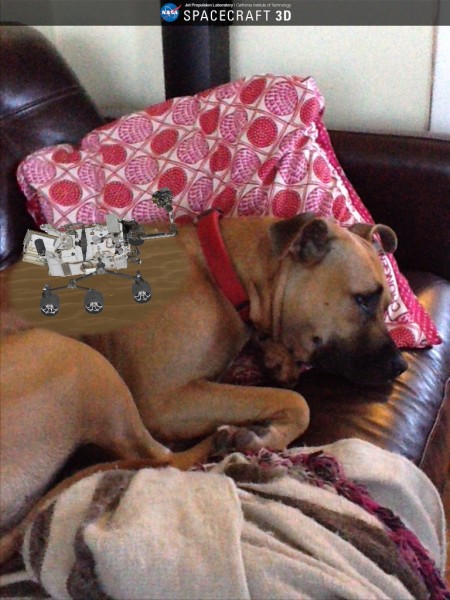After watching NASA’s rover Curiosity land safely—and with unbelievable panache—on the Martian surface late Sunday evening, I heard a shock jock on a local sports radio show bemoaning the attention the mission was garnering. “I guess I know this is a big deal to some people, but I think we’re going overboard here,” he said. “This must be the way science people feel when they look at how excited we get about the Super Bowl.”
When the immense technical feat of sending a one-ton, SUV-sized, nuclear-powered roaming laboratory across hundreds of millions of miles of interstellar space and then gracefully setting it down on Mars using a heat shield, parachute, retro rockets, and a “sky crane,” is denigrated into a trite swipe about excitable nerds, then, America, we have a problem.
The successful landing of the Mars Science Laboratory (MSL) in Gale Crater is possibly the most significant technological event of the last decade. It’s a testament to NASA’s hard work (the Mars Science Laboratory took nearly a decade of planning, research, and construction: tens of thousands of man-hours), technical expertise (including several innovations developed at NASA’s Jet Propulsion Laboratory in Pasadena, CA), and desire to take big risks.
Yet, kudos for NASA shouldn’t stop there. The government agency also deserves high-fives for their impressive campaign to turn this into a teachable moment both for students and students of education. They seized the opportunity to celebrate the importance of STEM education (science, technology, engineering, and math) to the mission, and spread their enthusiasm to students around the globe. NASA developed an eye-popping web app called Eyes on the Solar System that functions much like Google Earth and allowed users to follow along in real time with Curiosity’s heroic descent. They also released a fun augmented reality app to demonstrate how the rover operates, complete with controllable mast and robotic arm. (See a photo of my less-than-amused dog Luna as Curiosity makes its way over her back.)
 NASA’s efforts to use Mars missions to ignite a STEM passion in students began years ago when they began engaging classrooms in scientific analysis of data collected through Mars Exploration Student Data Teams. This crowd-sourced exploration of images and other data from the Mars Reconnaissance Orbiter reveals a potential for project-based learning that is both exciting for students and directly applicable to real world challenges.
NASA’s efforts to use Mars missions to ignite a STEM passion in students began years ago when they began engaging classrooms in scientific analysis of data collected through Mars Exploration Student Data Teams. This crowd-sourced exploration of images and other data from the Mars Reconnaissance Orbiter reveals a potential for project-based learning that is both exciting for students and directly applicable to real world challenges.
NASA’s motivation for actively promoting STEM is obvious enough. One assumes that future generations of scientists will face innumerable challenges associated with landing humans on Mars, keeping them alive, and returning them home. It’s exciting to see them look beyond this direct benefit, with their active promotion of the arts in education’s acronym of the moment. NASA’s pre-landing TV programming included an interview with Black Eyed Peas’ front man will-i-am, who has become a vocal advocate for turning STEM into STEAM (yay, arts!). NASA’s Imagine Mars Project invites classrooms to work with NASA scientists and engineers to imagine and design human communities on Mars. Throughout the standards-aligned project, students share their concepts and ideas via the arts, including audio, video, and design software. Lest you view this as an abstract mental exercise, remember that multiple lead scientists at NASA noted that the MSL mission is a foundational step towards a much larger goal—putting humans on Mars.
As the Maker Movement—built on access to inexpensive, user-friendly tools like the Arduino microprocessor—grows and our space exploration missions become both more adventuresome and more technical, getting young people excited about STEM (plus the arts) is a goal with real potential and importance. NewSchools is a proud partner to the 100Kin10 coalition which finds and attracts excellent STEM teachers to classrooms across America. Students seated in today’s school desks will be manning NASA’s Mission Control room in the near future. So, let’s celebrate NASA’s monumental accomplishment, as well as the science, technology, engineering, and mathematics—and, yes, art—behind it. Let’s find ways to celebrate these skills, and work together to make such an event a “Super Bowl Moment” for everyone.